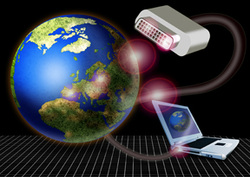
There was an abundance of information this week and I found myself desperately trying to absorb knowledge. One of the main themes this week is the importance of designing online instruction with a multimodal approach which addresses the many different learning styles. Emerging technologies continue to pave the way for dynamic, engaging, interactive, and immersive instructional tools. Web 2.0 has evolved into a new concept called Collaboration 2.0 enabling new levels of human interactivity in the realm of social networking. Two-way communication in a synchronous learning environment allows for real-time sharing of knowledge and immediate feedback. Communities of practice are formed amongst participants to facilitate the exchange of ideas and promote meaningful learning experiences. Newer studies no longer question whether these tools are being utilized. Instead, studies focus on what can create a more effective instructional strategy using multimodal methods in a Collaboration 2.0 setting. Here are a few key points to remember when producing media for instruction; present (deliver) information by incorporating images and text simultaneously with balance, use a layout design which enables easy viewing on the eyes, and augment delivery with verbal narration. To meet the social interaction component of instruction, complement media with Collaboration 2.0 tools such as blogs, wikis, and social bookmarking which supports dialogue and learning.
The reading is helpful because we need to remember that our brains work to traffic information in a bi-directional way. Different generational learners also mean different learning styles. In particular, millennial learners are digital natives and thrive in a multi-tasked environment. Without a doubt, learner characteristics vary and it is essential to design instruction with the 21st century learner in mind. Multimodal strategies activate different responses from different learners while knowledge acquisition occurs. If we consider a multimodal approach to instruction, we can position our learning environment to reach more learners. A learner can exercise flexibility to scaffold old and new knowledge in the learning process. This can be based upon individual preference, technical expertise, relevance, and cognitive skills.
In my personal experience, multimodal environments improve my acquisition of knowledge because different senses (auditory, visual, and verbal) are interactively stimulated. Observing, participating, and reflecting actively converts information into knowledge. When possible, actual experience of the information becomes experiential knowledge. I feel that my comprehension, retention, and critical thinking skills are better and produce higher quality results. All of this can be applied in a personal, professional, and academic context.
Whew! There is so much to learn and we are barely scratching the surface.
What's your preferred online learning environment? Asynchronous or synchronous? I consider this class a hybrid of both. We meet synchronously once a week and complete assignments asynchronously throughout the week. Instructional strategies for online courses have evolved over the last decade. Learning styles vary for each person and these differences must be taken into consideration when designing online instruction. Our reading material focused on the comparison of asynchronous and synchronous online learning environments. We have been assigned to teams and experienced moderating an online learning environment using a Web 2.0 audio-conferencing tool called Blackboard Collaborate. Our group met last Thursday, in Blackboard Collaborate, to discuss the reading material, establish a strategy for completing the assignment, and schedule a follow-up meeting. As it turns out, the session was quite short and we decided to do our work asynchronously using an online document in Google Docs. It is working out well for our team members.

Photo credit: PhotoXpress.com
We will be posting our synthesized summary of the readings in a class wiki page soon. We read about the R2D2 Model, read, reflect, display, and do. This method addresses the diverse learners in online courses, their preferences, varied Internet skill levels, and multi-generational backgrounds. We also read about the effects of audio-conferencing. Learners are generally more satisfied with Web tools that enable a more interactive and engaging environment. All of the reading made me wonder about my personal preferences. I have taken many online courses, some were completely asynchronous and some were a hybrid. I feel comfortable in either situation, however, I do appreciate the social aspect of a synchronous course. I am looking forward to reading the summaries of my peers who add value to my learning experiences!!

The objective of this blog is to journalize my experiences and thoughts in ETEC 622, eLearning Theory & Design. I hope my fellow classmates will share with me their experience and thoughts as well. I would love to receive feedback on my blog posts. It is always enlightening to share different perspectives and gain new understanding from others.
E-mail, blogs, and tweets! These are the main topics covered in our first synchronous session. Recent developments in technology have enabled web-based delivery of instruction. Additionally, computer-based communication tools can augment an online learning environment. We will be exploring the use of these tools to gain insight for designing effective strategies for delivering instruction via the web.
We have a great group of students! Dr. Bert randomly assigned the class to smaller groups to discuss online learning. Our group had a stimulating discussion about various components necessary to succeed in online learning; including careful planning for different learning styles and more. I enjoy learning from my peers and appreciate the different perspectives they bring to our discussions.
I look forward to a great semester!



 RSS Feed
RSS Feed
